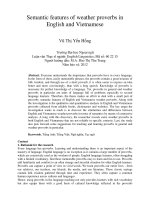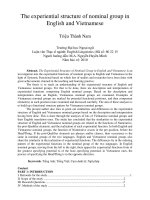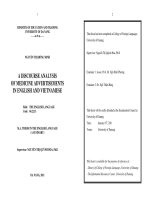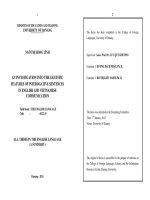The experiential structure of nominal group in English and Vietnamese
Bạn đang xem bản rút gọn của tài liệu. Xem và tải ngay bản đầy đủ của tài liệu tại đây (129.71 KB, 5 trang )
The experiential structure of nominal group in
English and Vietnamese
Triệu Thành Nam
Trường Đại học Ngoại ngữ
Luận văn Thạc sĩ ngành: English Linguistics; Mã số: 60 22 15
Người hướng dẫn: M.A. Nguyễn Huyền Minh
Năm bảo vệ: 2010
Abstract. The Experiential Structure of Nominal Group in English and Vietnamese is an
investigation into the experiential functions of nominal groups in English and Vietnamese in the
light of Systemic Functional based on which lots of studies and researches have been done with
great achievements claimed in the teaching and learning practice.
The thesis is to reach an understanding of the experiential structure of English and
Vietnamese nominal groups. For that to be done, there are description and interpretation of
experiential functions comprising English nominal groups. Based on the description and
interpretation done on English, Vietnamese nominal groups are examined. Examples of
Vietnamese nominal groups are marked for potential functional positions, and then component
element(s) in each position is/are examined and discussed carefully. The aim of these analyses is
to build up a functional structure pattern for Vietnamese nominal groups.
The present author also tries to point out similarities and differences in the experiential
structure of English and Vietnamese nominal groups based on the description and interpretation
having been done. This is done through the analyses of lots of Vietnamese nominal groups and
their English translation ones. The study has concluded that the similarities in the experiential
structure of English and Vietnamese nominal groups are related to the functions of Numerative,
the post-Qualifier elements, and the realization of each experiential function. In both English and
Vietnamese nominal groups, the function of Numerative occurs in the pre-position, before the
Head/Thing. If the post-Qualifier elements are phrases and/or clauses, their occurrence is the
same in nominal groups of the two languages. English and Vietnamese nominal groups also
share the similarity in the realization of experiential functions. The differences lie in the ordering
pattern of the experiential functions in the nominal group of the two languages. In English
nominal groups, moving from the left to the right, there appear the experiential functions from of
the greatest specifying potential to of the least specifying potential; in Vietnamese ones, the
process of specifying the Head/Thing is in the opposite direction.
Keywords. Tiếng Anh; Tiếng Việt; Cụm danh từ; Ngữ pháp
Content
PART 1: INTRODUCTION
I. Rationale for the study 1
II. Scope of the study 2
III. Research Questions 2
IV. Methods of the study 2
V. Methods of Analysis 3
PART 2: DEVELOPMENTS
CHAPTER 1: THEORETICAL BACKGROUND AND
REVIEW OF RELATED LITERATURE
I. Systemic Functional Grammar 4
II. Noun Phrase or Nominal Group: The problem of labeling 5
III. Noun Phrase/Nominal Group in Different Schools of Grammar 6
1. Noun Phrase in Structural Grammar and Generative Transformational Grammar 6
2. Noun Phrase in Functional Discourse Grammar 7
3. Nominal Group in Systemic Functional Grammar 8
IV. The Nominal Group in English 9
1. An overview of English Nominal Group 9
2. The experiential structure of the nominal group in English 11
2.1. Premodifier 11
2.1.1 Deictic 11
2.1.2. Numerative. 13
2.1.3. Epithet 13
2.1.4. Classifier 13
2.2. The Head: The Thing 15
2.3. The Postmodifier – the Qualifier 16
3. Summary on the experiential structure of the nominal group in English 16
CHAPTER 2: NOMINAL GROUP IN VIETNAMESE
I. An overview of studies on Vietnamese Nominal Group 18
II. Nominal Group in Vietnamese 19
2.1 The Head: the Thing 20
2. 2. Premodifier 23
2.2.1. Position (-1) 24
2.2.2 Position (-2): Cái 24
2.2.3. Position (- 3) 25
2.2.4. Position (- 4) 26
2.3. Postmodifier 26
2.3.1. The Postmodifier is a word 26
2.3.1.1. Position (1): Classifier 26
2.3.1.2 Position (2): Epithet 27
2.3.1.3 Position (3): Deictic 27
2.3.2. The postmodifier is a phrase or clause 28
CHAPTER 3: STRUCTURAL SIMILARITIES AND DIFFERENCES
OF THE NOMINAL GROUP IN VIETNAMESE AND ENGLISH
I. Similarities. 29
1.1. NGs in English and Vietnamese have the same logical structure 29
1.2. The similar realization of the experiential functions 30
1.3. The Numerative occurs before the Head 30
1.4. The structural similarity in the post-position phrases and clauses 30
II. Differences 31
2.1. The function of Deictic 31
2.2. The function of Epithet 32
2.3. The function of Classifier 32
III. Concluding Remark 33
PART 3: CONCLUSION 36
List of Reference 38
INTRODUCTION
I. Rationale for the study
Over the last few decades, the modern linguistics has seen the remarkable developments
of functional linguistics in which the theory of systemic functional grammar developed by
Halliday is said to have the greatest influences. Vietnamese linguistics has also initiated new
trends, basing on the functional grammars. Some Vietnamese linguists, such as, Cao Xuan Hao
with Sơ thảo ngữ pháp chức năng (1991), Hoang Van Van with Ngữ pháp kinh nghiệm của cú
tiếng Việt: Mô tả theo quan điểm chức năng hệ thống (2001), and Diep Quang Ban with Ngữ
pháp tiếng Việt (2008) are the first to apply the theory of Systemic functional grammar into the
interpretation of Vietnamese language. And their studies marked new important changes in the
approaches to Vietnamese language.
These works have settled a functional base for other further studies on Vietnamese under
the light of the Systemic functional grammar. In these works, functional aspects and
relationships, such as the issues of Theme, Mood, and Process of transitivity of clauses have
been described. Besides, structures below clauses, such as, nominal groups, also have received
some interpretations. However, on Vietnamese language in general and Vietnamese nominal
groups in particular, there have to be more functional studies because theory of functional
grammar can be still considered "new" in Vietnamese linguistics. That, in other words, means
the number of people who know and pay attention to it is still limited.
On Vietnamese nominal groups, although there have been some studies, the issue still has
some questions to be answered and some debates to be solved, and needs further investigations.
One question raised to be answered is: Can the experiential functions in Vietnamese nominal
groups be clearly determined based on the systemic functional grammar? One debate that has not
been solved completely is about the determination of the component element(s) of the Head and
Thing in Vietnamese nominal groups.
Furthermore, for Vietnamese learners of English, the full understanding of nominal
groups in English and Vietnamese has been proved to be of the great importance, especially,
when they want to develop skills of high proficiency, such as translation. As a matter of fact,
dense scientific terms, expressions of complicated abstract issues, etc. are in the forms of
nominalization, and their meanings are not easy to be grasped. The understanding of the
experiential functional components and the effects that each component can have on the whole
meaning of the nominal group in the two languages can help much in this case.
Those discussed above are the reasons for doing this thesis which is titled: The
Experiential Structure of Nominal Groups in English and Vietnamese.
II. Research Questions
The aims of the study are stated in the following research questions:
1. How are Nominal Groups in English and Vietnamese constructed in the light of Systemic
Functional Grammar?
2. What are the similarities and differences in the functional construction of the Nominal
Group in English and Vietnamese?
III. Scope of the study
As can be inferred from the research questions, the study focused on the experiential
functions of nominal groups in the two languages. The study is to describe the experiential
functional components of which the nominal group is comprised. Based on the descriptions, the
comparison between English and Vietnamese nominal groups will be made. Due to limited time,
the issue of reference of nominal group/noun phrase is put out of the study. That will lead to the
fact that some relevant structural features of the nominal group will not be discussed fully.
The study is within the nominal group structure and the relations of its functional
components. Nominal groups that are used for the description and demonstration tend to be of
the standard ones.
IV. Methods of the study
The basic methods used in this thesis are descriptive and contrastive methods of language
research. First, a description of NG in English is given in the chapter of theoretical background
and literature review, and then that in Vietnamese will be done in the next chapter. Nominal
groups that are used as examples for analyses and descriptions are taken from books of different
genres in English and Vietnamese. The contrastive method is used to figure out the similarities
and differences between nominal groups in the two languages.
V. Methods of Analysis
To answer the first question, with the Systemic Functional approach the study will look
into the structures of the nominal groups in the two languages. Each functional component of the
nominal group will be described separately, and defined first in the interpretation of English
nominal groups. In the description of Vietnamese nominal groups, there will be marked positions
in the structure; each position will be examined to determine the function that the element in that
position realizes. Examples of Vietnamese nominal groups will be used accompanied with their
English translations.
The answer to the second research question is obtained through comparing the typical
orderings of the functional components of the nominal groups in the two languages. For the
demonstration of the similarities and differences, examples of English - Vietnamese nominal
groups are given. The similarities and differences are intended for further studies and unstated
implications for learning and teaching English for Vietnamese learners.
References
- Bloors, T. & Bloors, M. (1995). The Functional Analysis of English. London:
Arnold.
- Brown, K (Editor-in-chief). The Encyclopedia of Language and Linguistics,
Elsevier, 2005
- Cao Xuân Hạo (1991). Sơ Thảo Ngữ Pháp Chức Năng. Hà Nội: Nhà xuất bản
Khoa học xã hội.
- Crystal, D. (1985). Linguistics. London: Penguin.
- Crystal, D. (1987). The Cambridge Encyclopedia of the English Language.
Cambridge: Cambridge University Press.
- Diệp Quang Ban (2008). Ngữ pháp tiếng Việt. Hà Nội: Nhà xuất bản Giáo dục.
- Đinh Văn Đức (2001). Ngữ pháp tiếng Việt: từ loại. Hà Nội: Nhà xuất bản Đại học
Quốc gia Hà Nội.
- Eggins, S. (1994). An Introduction to Systemic Functional Linguistics. London:
Continuum, Wellington House.
- Hoàng Văn Vân (2002). Ngữ Pháp Kinh nghiệm của cú Tiếng Việt. Hà Nội: Nhà
xuất bản Khoa học xã hội.
- Halliday, M.A.K (1994). An Introduction to Functional Grammar. London: Arnold
- Huddleston, R. (1976). An Introduction to English. Transformational Syntax.
London: Longman.
- Lyon, J. (1995). Linguistic Semantics. Cambridge: Cambridge University Press.
- Morley, G.D. (2000). Syntax in Functional Grammar. London: Continuum.
- Nguyen Lân (1956). Ngữ Pháp Việt Nam. Hà Nội: Nhà xuất bản Giáo dục.
- Nguyễn Tài Cẩn (1996). Ngữ pháp tiếng Việt: Tiếng - Từ ghép - Đoản ngữ Hà
Nội:Nhà xuất bản Đại học Quốc gia Hà Nội.
- The Noun Phrase in Functional Discourse Grammar (2008), edited by Daniel Garcia
Velasco & Jan Rijkhoff. Berlin/New York: Mouton de Gruyter.









